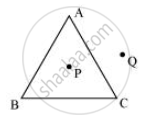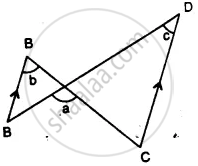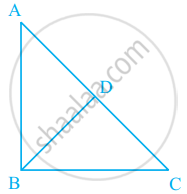Advertisements
Advertisements
Question
Draw a rough sketch of a triangle ABC. Mark a point P in its interior and a point Q in its exterior. Is point A in its exterior or in its interior?
Solution

Point A lies on the given ΔABC.
APPEARS IN
RELATED QUESTIONS
The angles of a triangle are (x − 40)°, (x − 20)° and `(1/2x-10)^@.` find the value of x
The bisectors of base angles of a triangle cannot enclose a right angle in any case.
Define a triangle.
In Δ ABC, if u∠B = 60°, ∠C = 80° and the bisectors of angles ∠ABC and ∠ACB meet at a point O, then find the measure of ∠BOC.
In the given figure, show that: ∠a = ∠b + ∠c

(i) If ∠b = 60° and ∠c = 50° ; find ∠a.
(ii) If ∠a = 100° and ∠b = 55° : find ∠c.
(iii) If ∠a = 108° and ∠c = 48° ; find ∠b.
One of the angles of a triangle is 65°. If the difference of the other two angles is 45°, then the two angles are
In the given figure, AB is parallel to CD. Then the value of b is
Match the following:
| Column A | Column B |
| (i) No sides are equal | Isosceles triangle |
| (ii) One right angle | Scalene triangle |
| (iii) One obtuse angle | Right angled triangle |
| (iv) Two sides of equal length | Equilateral triangle |
| (v) All sides are equal | Obtuse angled triangle |
In figure, AB = BC and AD = BD = DC. The number of isosceles triangles in the figure is ______.
Can we have two acute angles whose sum is an obtuse angle? Why or why not?
